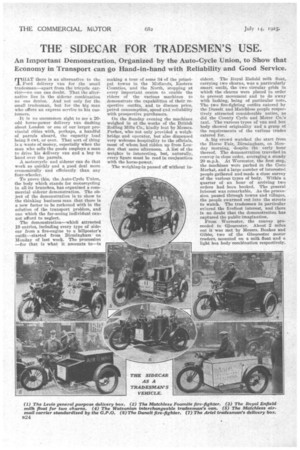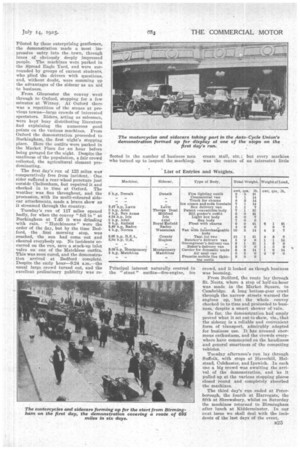THE SIDECAR FOR TRADESMEN'S USE.
Page 8

Page 9

If you've noticed an error in this article please click here to report it so we can fix it.
An Important Demonstration, Organized by the Auto-Cycle Union, to Show that Economy in Transport can go Hand-in-hand with Reliability and Good Service.
MEAT there is an alternative to the J. Ford delivery van for the small tradesman—apart from the tricycle carrier—no one can doubt. That the alternative lies in the sidecar combination no one denies. And not only for the small tradesman, but for the big man who offers an express servrce to his customers.
It is no uncommon sight to see a 20odd horse-power delivery van dashing about London or one of our larger provincial cities with, perhaps, a handful of parcels aboard, the capacity load being S cwt. or over. That sort of thing is awaste of money, especially when the man who sells the goods employs a man to drive his delivery van and a boy to hand over the parcels.
A motorcycle and sidecar can do that work as quickly and a good deal more economically and efficiently than any four-wheeler.
To prove this, the Auto-Cycle Union, the body which stands for motorcycling in all its branches, has organized a commercial sidecar demonstration. The object of the demonstration is to show to the thinking business man that there is a new factor to be reckoned with in the solution of the transport problem, and one which the far-seeing individual cannot afford to neglect The demonstration—which attracted 19 entries, including every type of sidecar from a fire-engine to a billposter's outfit—started from Birmingham on • Monday of last week. The procession —for that is what it amounts to—is
making a tour of some 34 of the principal towns in the Midlands, Eastern Counties, and the North, stopping at every important centre to enable the riders of the various 'machines to demonstrate the capabilities of their respective outfits, and to dis6iss price, petrol consumption, speed and reliability with prospective pUrchasers.
On the Sunday evening the machines weighed in at the works of the British Rolling Mills Co., kindly lent by Messrs. Parker, who not only provided a weighbridge and operator, but also dispensed Very welcome hospitality to the officials, most of whom had ridden up from Loudon that same afternoon. A list of the weights is interesting, but, naturally, every figure must be read in conjunction with the horse-power.
The weighing-in passed off without in cident. The Royal Enfield milk float, carrying two churns, was a particularly smart outfit, the two circular grids in which the churns were placed in order to prevent movement and to do away with lashing, being of particular note. The two fire-fighting outfits entered by the Dunelt and Matchless people respectively attracted considerable notice, as did the County Cycle and Motor CO's taxi. The various types of van and box body showed originality and a grasp of the requirements of the various trades catered for.
A. big crowd watched the start from the Horse Fair, .Birmingham, on Monday morning, despite the early hour thereof. The demonstration travelled in convoy in elope order, averaging a steady 20 m.p.h. At Worcester, the first stop, the machines were parked in the Corn Mark,:t, and a large number of interested people gathered and made a close survey of the various types of body. Within a quarter of an hour of arriving two orders had been booked. The general interest was remarkable. As the procession passed through towns and villages, the people swarmed out into the streets to watch. The tradesmen in particular evinced the liveliest interest, and there is no doubt that the demonstration has captured the public imagination.
From Worcester, the convoy proceeded to Gloucester. About 2 miles out it was met • by Messrs. Boakes and Gibbs, two of the Gloucester motor traders, mounted on a milk float and a light box body combination respectively. Piloted by these enterprising gentlemen, the demonstration made a most impressive entry into the town, through lanes of obviously deeply impressed people. The machines were parked in the Spread Eagle Yard, and were surrounded by groups of earnest students, who plied the drivers with questions, and, without doubt, were summing up the advantages of the sidecar as an aid to business.
From Gloucester the convoy went through to Oxford, stopping for it few minutes at Witney. At Oxford there was a repetition of the scenes at previous towns—large crowds of interested spectators. Riders, acting as salesmen, were kept busy distributing literature and explaining the numerous good points on the various machines. From Oxford the demonstration proceeded to Buckingham, the first night's stopping place. Here the outfits were parked in the Market Place for an hour before being garaged for the night. Despite the smallness of the population, a fair crowd collected, the agricultural element predominating.
The first day's run of 123 miles was comparatively free from incident. One rider suffered a rear-wheel puncture just outside Cheltenham, but repaired it and checked in to time at Oxford. The weather was fine throughout, and the procession, with its multi-coloured sidecar attachments, made a brave show as it streamed through the country.
Tuesday's run of 117 miles opened badly, for when the convoy "fell in" at Buckingham at 7.45 it was drizzling with rain. " Hutchinsons " were the order of the day, but by the time Bedford, the first morning stop, was reached, the sun had come out and cheered everybody up. No incidentioccurred on the run, save a stuck-up inlet valve on one of the Matchless outfits. This was soon cured, and the demonstration arrived at Bedford completd. Despite the early hour-9.24 am.—the usual large crowd turned out, and the excellent preliminary publicity was re
crowd, and it looked as though business was booming.
From Bedford, the route lay through St. Neots, whore a stop of half-an-hour was made in the Market Square, to Cambridge. A long bottom-gear crawl through the narrow streets warmed the engines up, but the whole convoy checked in to time and proceeded to business, despite a smart shower of rain.
So far, the demonstration had amply proved what it set out to show, viz., that the sidecaK is a reliable and convenient form of transport, admirably adapted for business use. It has aroused enormous enthusiasm, and the crowds everywhere have commented on the handiness and general smartness of the competing vehicles.
Tuesday afternoon's run lay through Suffolk, with stops at Haverhill, Halstead, Colchester, and Ipswich. In each one a big crowd was awaiting the arrival of the demonstration, and he it pulled up at the various stopping places closed round and completely absorbed the machines.
The third day's run ended at Peterborough, the fourth at Harrogate, the fifth at Shrewsbury, whilst on Saturday the machines returned to Birmingham after lunch at Kidderminster. In our next issue we shall deal with the incidents of the last days of the event.




























